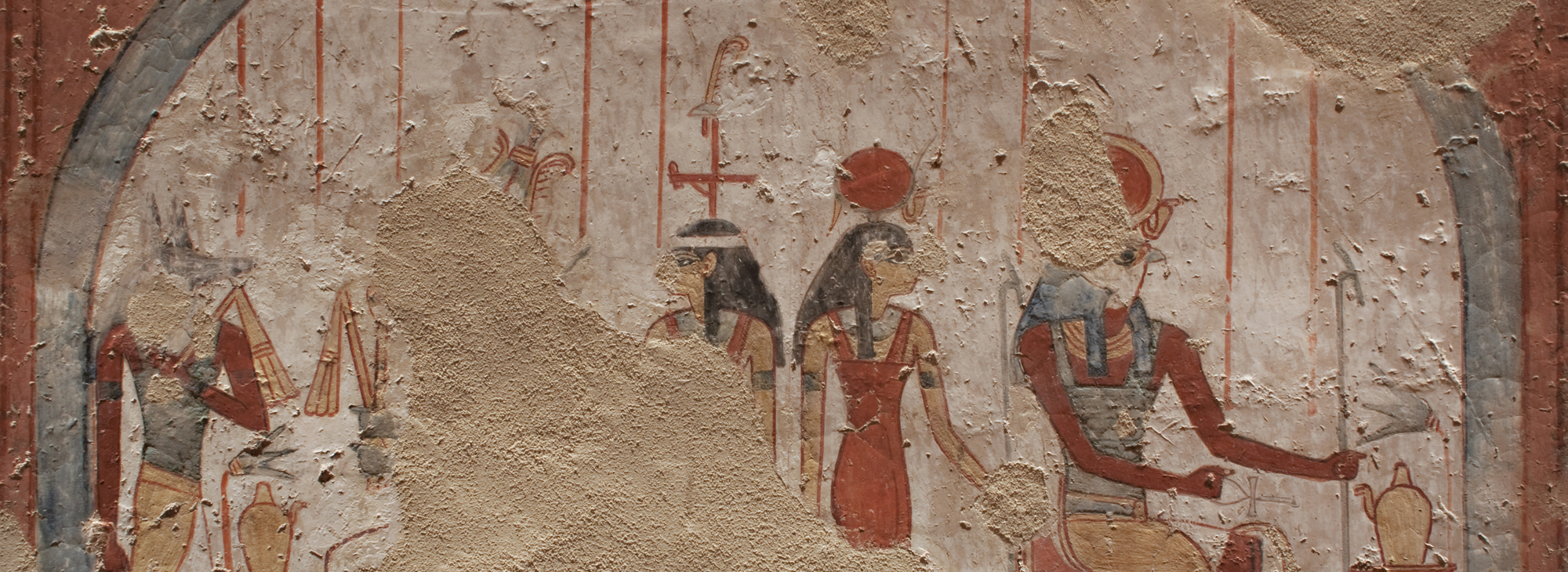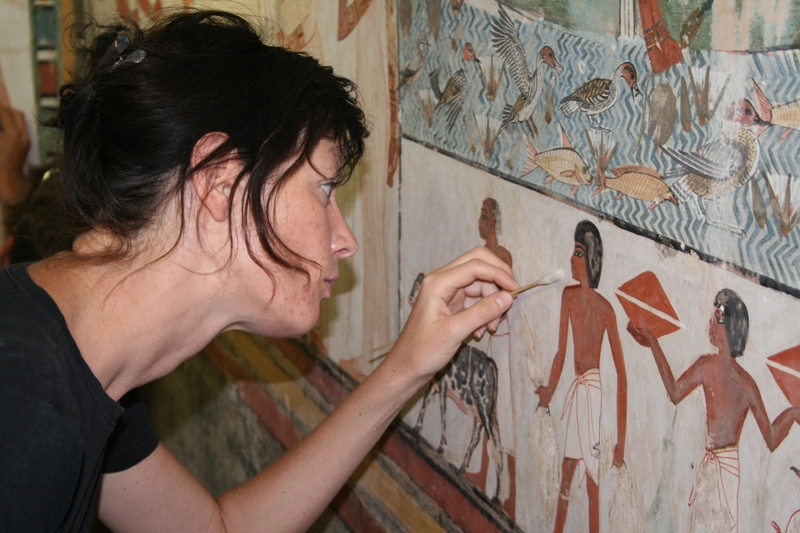- Era18th dynasty
- Project DirectorMelinda Hartwig
- LocationLuxor
- AffiliationGeorgia State University
- Project SponsorUSAID
- Project Dates2007-2009
Cut into the cliffs of the Theban necropolis in Luxor’s West Bank, the tomb of Menna is known for the colorful and remarkably well-preserved paintings that adorn the chapel walls. The tomb has been one of the chief attractions on the West Bank for the last several centuries. In the fall of 2007 and 2008, ARCE president emeritus Melinda Hartwig directed a project to conserve the wall paintings in the tomb of Menna. Georgia State University, in partnership with the American Research Center in Egypt, several European centers of archaeometry and the Supreme Council of Antiquities (the predecessor to the Egyptian Ministry of Antiquities) with support from the U.S. Agency for International Development carried out the project.
Although little is known about Menna, his tomb provides some insight into his life as a member of ancient Egypt’s elite class. Titles that appear in his tomb indicate he was a scribe and an overseer of fields belonging to the pharaoh and the temple of Amun-Re. In the book published on the project, The Tomb Chapel of Menna (TT69): The Art, Culture, and Science of Painting in an Egyptian Tomb – the fifth installment of the ARCE Conservation series – Hartwig explained, “Menna would have supervised a number of field scribes and reported to the central field administration in the office of the granaries of the pharaoh.” She further added, “From the scenes depicted in his tomb, we can see that Menna supervised delegations who measured the fields, brought defaulters to justice, inspected field work and recorded the yield of the crop.”
As the owner of the tomb, Menna is the central character in the chapel’s decorative program. In almost all of his depictions, Menna wears the sbyw-collar, known as the Gold of Honor. This indicates he was recognized formally by the king. Menna’s wife, Henuttawy, appears in nearly every scene in the tomb chapel (a sculpture bust of her is in the Egyptian Museum in Cairo). Her primary title was the Chantress of Amun, a position occupied by noble women in the 18th dynasty. Henuttawy may have been the daughter of the Second Prophet of Amun, Amenhotep-si-se. Her other title, Mistress of the House, indicates that she owned property when she married Menna.
The detailing and overall style of the tomb paintings are specific to the reign of Amenhotep III. On this point, Hartwig elaborated, “Similar ochre-toned skin color between men and women, faces with small noses and mouths, elongated eyes with pupils that disappear under the upper eyelid, and straying wig tendrils are common in figures that date to the reign of Amenhotep III.” Additional support for this date is provided by the tomb architecture and the prominent appearance of the sbyw-collar, which Hartwig suggests was received by Menna during one of Amenhotep III’s Sed Festivals. An especially notable image in the tomb is a scene depicting the Weighing of the Heart, which is one of the first times such a scene appears in an elite Theban tomb. As described in the ancient Egyptian Book of the Dead, the scene depicts Osiris, the god of the dead, weighing the heart of the deceased against the Feather of Truth to judge the morality of a life.
Considering the historic and artistic significance of the wall paintings, the joint project of Georgia State University and ARCE was well-timed and essential. Much of the first season in 2007 was dedicated to producing a condition survey, where any damage and previous interventions were noted and photographed. Existing damage to the wall reliefs primarily consisted of wear from water and salt, peeling and flaking paint, detached plaster, cracks in the walls and an invasion of wasp nests, according to chief conservator Bianca Madden.
Additionally, the team conducted a careful, non-invasive analysis of the original decoration covering the wall through a combination of spectroscopic technologies, including Raman spectroscopy, ultraviolet imaging and UV fluorescence. One of the first uses of these archaeometric methods in an Egyptian tomb conservation project, they avoided risk of damage to the wall paintings and provided the project’s conservation team with critical information to plan their intervention strategies.
The 2008 season focused on further conservation treatments. Conservators removed older repairs that used outdated methods on the wall surfaces and replaced them with a smooth layer of lime mortar mixed with sand in a color that was closer to the original wall color. Overall conservation and cleaning of the wall paintings revealed the striking colors of the images. A zig-zag pattern that runs along the ceiling of the tomb chapel is particularly eye-catching, given its vibrant design and deep yellow pigment. On the success of the project, Hartwig noted, “The tomb of Menna is in many ways an ideal Theban tomb structure, and the joint GSU-ARCE project not only succeeded in conserving its decoration but in producing the first scientific publication on the tomb and its contents.”


